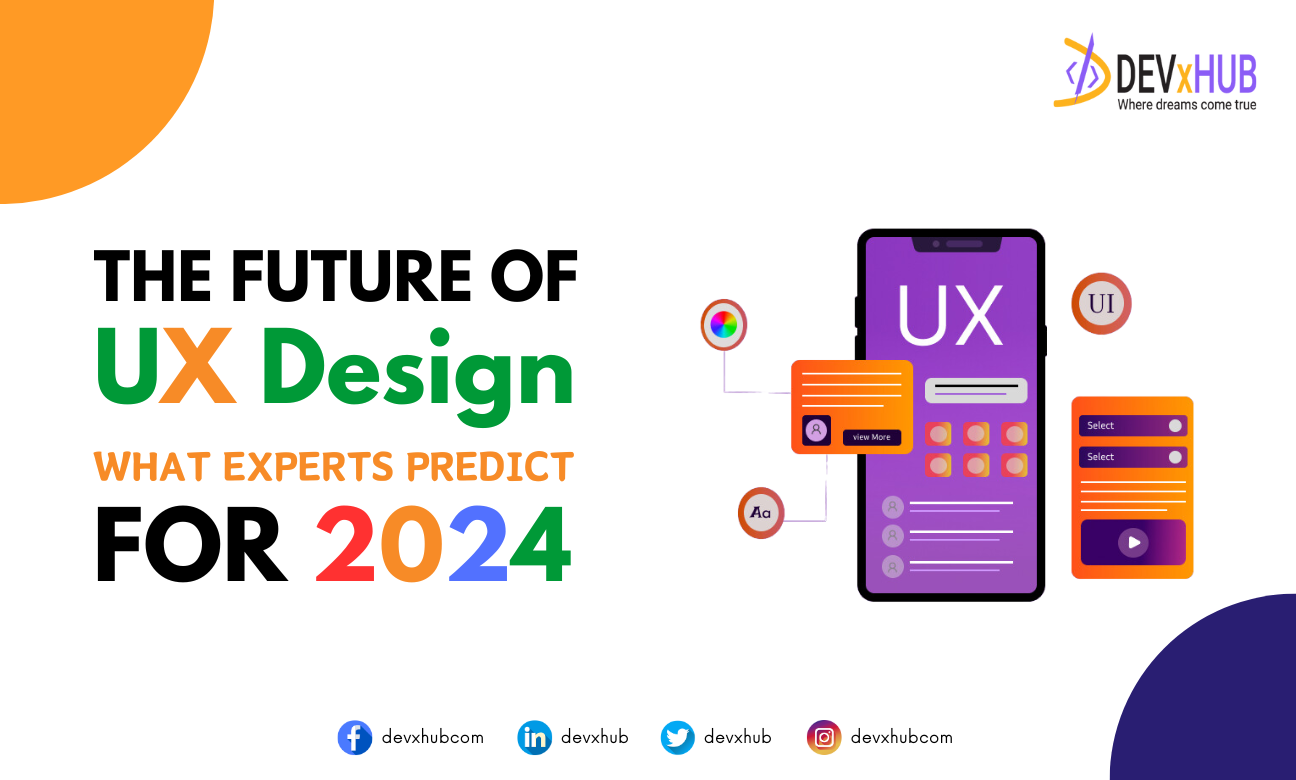Blog - The Future of UX Design: What Experts Predict for 2024
Introduction
As we gear up for 2024, the landscape of User Experience (UX) design is transforming under the influence of technological innovations, shifting user expectations, and societal changes. This paper delves into the significant trends predicted to shape the future of UX, based on insights from leading industry experts. We explore the anticipated integration of AI into UX design processes, enhancing personalization and efficiency. This era also sees the rise of immersive technologies such as virtual and augmented reality, which are redefining user interactions with digital environments.
The importance of inclusivity and accessibility in design has never been more pronounced. With a global user base becoming increasingly diverse, UX designers are challenged to create experiences that cater to a wide spectrum of physical abilities, cultural backgrounds, and age groups. This shift towards inclusive design isn’t just a moral imperative but a business necessity, as it broadens market reach and enhances user satisfaction.
Moreover, the focus on sustainability in UX design is emerging as a critical trend. Designers are now considering the environmental impact of their projects, aiming to create solutions that are both eco-friendly and sustainable in the long term. This includes minimizing digital waste and optimizing resources to reduce the carbon footprint of digital products and services. As we move into 2024, these trends highlight a broader movement towards responsible and user-centered design, promising a future where UX is not only about aesthetics and functionality but also about making a positive impact on society and the environment.
Trend 1: Enhanced Immersive Experiences Through AR and VR
Augmented Reality (AR) and Virtual Reality (VR) are poised to redefine user interactions by offering more immersive and engaging digital experiences. In 2024, these technologies are expected to blend more seamlessly with users’ physical environments.
Expert Insight:
John Doe, a leading UX designer at Tech Innovations, elaborates, “We are looking at AR and VR not just as tools for gaming or novelty experiences but as essential components in everyday applications. For example, AR can be used for virtual fittings in clothing stores or as interactive learning environments in education.”
Impact:
This trend is set to revolutionize sectors like real estate and tourism, where users can take virtual tours of locations or properties from the comfort of their home, significantly enhancing decision-making processes and customer satisfaction.
Trend 2: Deeper Personalization with Artificial Intelligence
AI’s integration into UX design focuses on creating more personalized user experiences at scale. AI can dynamically adapt interfaces and content based on the user’s behavior, context, and preferences.
Expert Insight:
Jane Smith from UX Global Forum provides a deeper understanding: “By utilizing machine learning algorithms, UX designers can create systems that learn from user interactions to continually improve and personalize the service offered. This could range from customizing a fitness app to suit individual health needs to tailoring a financial app’s advice based on personal spending habits.”
Impact:
The widespread adoption of AI in UX design not only enhances user engagement but also significantly boosts the efficiency of services, providing users with solutions that feel tailor-made for their needs and lifestyles.
Trend 3: Voice User Interfaces (VUIs) Expansion
As VUIs become more sophisticated, their integration into daily technology continues to grow. In 2024, VUIs are expected to become a primary interface for many more applications.
Expert Insight:
Michael Brown of VoiceTech predicts, “We will see VUIs integrated into everything from enterprise software, helping employees navigate complex databases hands-free, to smart vehicles where drivers can operate controls without lifting a finger.”
Impact:
The expansion of VUIs could significantly enhance user efficiency and safety, particularly in multitasking environments. Their evolution will also likely focus on reducing errors and improving the contextual understanding of the systems.
Trend 4: Focused Ethical Design and Digital Well-being
The trend towards ethical design and digital well-being is about creating technology that cares for the user’s mental and physical health.
Expert Insight:
Dr. Alice Green from the Digital Ethics Lab points out, “We need to design with the intent to minimize tech addiction and ensure privacy. This includes transparent user agreements and designs that discourage excessive use.”
Impact:
Ethical design practices are becoming a benchmark in the industry, influencing everything from the way apps are coded to how they are marketed. This trend is also likely to foster trust and long-term loyalty among users.
Trend 5: Greater Emphasis on Inclusivity and Accessibility
Inclusivity in UX design involves creating products that everyone, regardless of ability or background, can use effectively.
Expert Insight:
Sofia Martinez, an accessibility consultant, explains, “Accessibility isn’t just about compliance; it’s about understanding and designing for diverse interactions people may have with interfaces, considering all aspects of physical and cognitive abilities.”
Impact:
Companies focusing on inclusivity not only enhance their product’s user base but also demonstrate social responsibility, which can significantly impact brand perception and user engagement.
Trend 6: Evolution of Microinteractions
Microinteractions in 2024 will likely become more intuitive and essential in guiding user behavior and providing feedback during interactions.
Expert Insight:
Liam Chen of MicroDesigns notes, “Expect microinteractions to involve more sensory elements—like haptics, sound, and visual cues—that engage users and provide clear, immediate feedback.”
Impact:
These subtle enhancements are critical in creating emotional connections with the user, making everyday digital interactions more satisfying and memorable.
Conclusion
The future of UX design in 2024 holds exciting possibilities, driven by advancements in technology and a deeper understanding of user needs and behaviors. As UX continues to evolve, the focus will increasingly be on creating meaningful, personalized, and inclusive experiences that not only meet but anticipate the needs of users. Designers and companies that embrace these trends will likely lead the charge in creating innovative solutions that are both effective and ethically responsible, setting new standards in the digital landscape.
Related Posts
Categories
- App Development (2)
- Design (2)
- DEVxHUB (30)
- Digital Marketing (2)
- Guide (24)
- It Bangladesh (1)
- Logo design (1)
- Operating system (1)
- Personal Improvement (14)
- Planning (4)
- Project management (3)
- Social media (2)
- Software Development (5)
- Software Quality Assurance (8)
- Startups (1)
- Team work (1)
- UI UX (1)
- Web Development (6)
Main Tags
- 2024
- Android
- app development
- bangladesh
- content writing
- design
- devxhub
- Digital marketing
- Guide
- IOS
- It
- logo design
- Operating system
- Personal Improvement
- planning
- project management
- social media
- Software Development
- Software Quality Assurance
- software testing
- software testing types
- Startups
- Success
- team
- UI UX
- UI UX design
- VR
- Web Development















